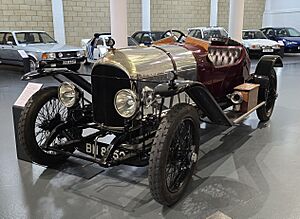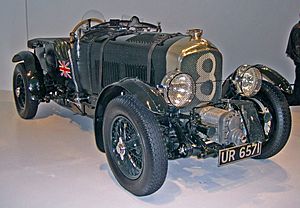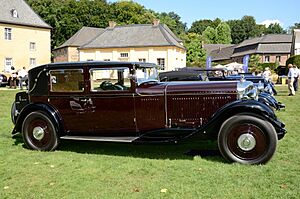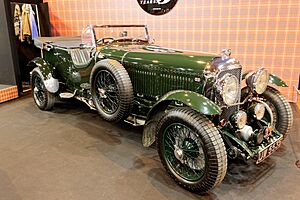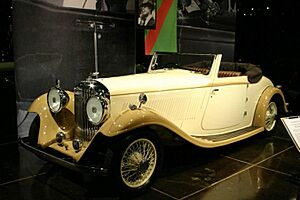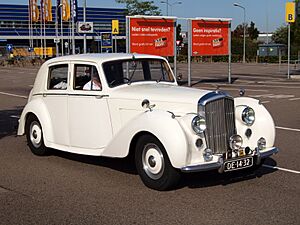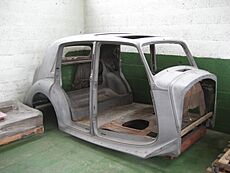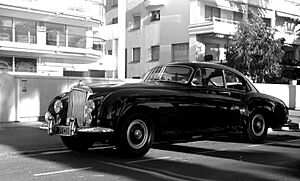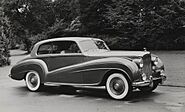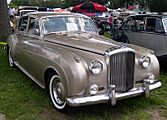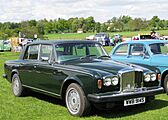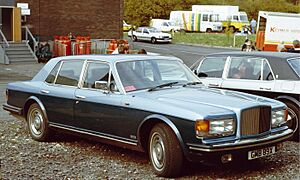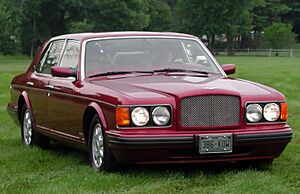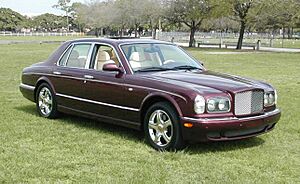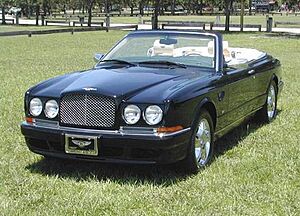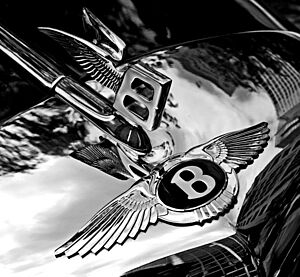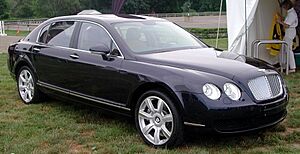Bentley facts for kids
 |
|
|
Formerly
|
|
|---|---|
| Subsidiary | |
| Industry | Automotive |
| Fate |
|
| Founded | 18 January 1919 |
| Founders |
|
| Headquarters |
,
England
|
|
Area served
|
Worldwide |
|
Key people
|
|
| Products |
|
|
Production output
|
|
| Services | Automobile customisation |
| Revenue |
|
|
|
|
Number of employees
|
3,600 (2013) |
| Parent | Audi |
Bentley Motors Limited is a famous British company. They design and make super fancy cars and SUVs. The company's main office is in Crewe, England. W. O. Bentley (1888–1971) started Bentley in 1919. It quickly became known for winning the tough 24 Hours of Le Mans race many times. Bentley won in 1924, 1927, 1928, 1929, 1930, and again in 2003. Since 1998, Bentley has been part of the Volkswagen Group. Since 2022, it has been managed by VW's luxury brand, Audi.
Some of Bentley's most famous cars include the old sports-racing Bentley 4½ Litre and Bentley Speed Six. More recent popular models are the Bentley R Type Continental and Bentley Arnage. Today, Bentley makes cars like the Flying Spur, Continental GT, and Bentayga. These cars are sold all over the world.
Most Bentley cars are put together at the company's factory in Crewe. A few are assembled at Volkswagen's factory in Dresden, Germany. Parts for the Continental are made in Zwickau, and for the Bentayga at the Volkswagen Bratislava Plant.
Bentley and Rolls-Royce have a long, shared history. Rolls-Royce bought Bentley in 1931 when Bentley was having money problems. Later, in 1971, Rolls-Royce itself faced financial trouble. The UK government took control of the company. They split it into two parts: an airplane engine company (Rolls-Royce Plc) and a car company (Rolls-Royce Motors Limited, which included Bentley). Rolls-Royce Motors was then sold to another company called Vickers. In 1998, Vickers sold Rolls-Royce to Volkswagen AG. This deal included the Bentley name and logos.
Contents
The Story of Bentley Cars
How Bentley Started (1919–1931)
Before World War I, Walter Owen Bentley and his brother, Horace Millner Bentley, sold French cars. But Walter, known as W.O., really wanted to design his own cars. In 1913, he saw an aluminium paperweight. He thought aluminium would be great for making lighter car parts instead of heavy iron. The first Bentley aluminium parts were used in airplane engines during World War I.
W.O. Bentley officially started Bentley Motors Limited on January 18, 1919. This was the same day the meeting to end World War I began. In October, he showed off a car frame at the London Motor Show. An officer from the Royal Flying Corps, Clive Gallop, designed a special engine for it. By December, the engine was ready. The first cars were supposed to be delivered in 1920, but it took longer. They finally arrived in September 1921. Bentley cars became famous for being very strong and reliable. They competed in races and hill climbs.
Bentley's first big race was the 1922 Indianapolis 500. This race usually had very special racing cars. Bentley entered a changed road car. It was driven by Douglas Hawkes and his mechanic. Hawkes finished the whole 500 miles and came in 13th place. After that, the team quickly went back to England for another race.
Captain Woolf Barnato and Bentley
Captain Woolf Barnato was a strong man, so people called him "Babe." In 1925, he bought his first Bentley car. He won many races with it. Just one year later, he bought the whole Bentley company.
Bentley always needed more money. But after a big win at the Le Mans race in 1924, Barnato decided to help. He invested a lot of money, more than £100,000, which saved the company. He became the chairman and put even more money into the business. With this new money, W.O. Bentley could design a new generation of cars.
The Bentley Boys and Racing
The Bentley Boys were a group of British car lovers. They included Barnato, Sir Henry "Tim" Birkin, and other wealthy people. Many of them had been in the military. They loved Bentley cars and helped keep the brand famous for its speed. Bentley cars won the 24 Hours of Le Mans race four times in a row, from 1927 to 1930.
Sir Henry Birkin created the special 4½-litre "Blower Bentley" in 1929. He made five racing versions of this car. Birkin decided to sell this model before it was fully ready. Because of this, it was not always reliable.
In March 1930, Barnato made a famous bet. He raced his 6½-litre Bentley Speed Six against a train called Le Train Bleu. He drove from Cannes, France, to Calais, then took a ferry to Dover, England, and finally drove to London. He won the race against the train!
Barnato drove a special Bentley car in this race. Two months later, he got another Speed Six with a sleek design. Both cars became known as the "Blue Train Bentleys." People often confuse the second car with the one that actually raced the train. A painting shows the car racing next to the train, but this never actually happened.
Famous Cricklewood Bentleys
- 1921–1929 3-litre
- 1926–1930 4½-litre & "Blower Bentley"
- 1926–1930 6½-litre
- 1928–1930 6½-litre Speed Six
- 1930–1931 8-litre
- 1931 4-litre
The first Bentley was the three-litre. But customers wanted bigger cars, so a 4½-litre model came next. The most famous car from this time is the 4½-litre "Blower Bentley." It had a special part called a supercharger sticking out from the front. This car was not as strong as the 6½-litre for racing. However, in 1930, Birkin amazingly finished second in a big race in France with a Blower Bentley.
The 4½-litre model also became famous in books as the car of James Bond. In the TV show The Avengers, the character John Steed also drove a Bentley.
The new eight-litre car was very successful. But in 1931, Barnato's money ran out. Another company, Napier, wanted to buy Bentley. To stop this, Rolls-Royce bought Bentley Motors. They didn't want Bentley to compete with their own expensive cars.
Bentley's Le Mans Wins
Bentley had amazing success at the 24 hours of Le Mans race:
- 1924: 1st place (3-Litre)
- 1927: 1st, 15th, 17th places (3-Litre)
- 1928: 1st, 5th places (4½-litre)
- 1929: 1st place (Speed Six); 2nd, 3rd, 4th places (4½-litre)
- 1930: 1st, 2nd places (Speed Six)
Bentley stopped racing right after winning at Le Mans in 1930. They said they had learned enough about speed and how to make reliable cars.
Bentley's Financial Troubles
The big economic problems of 1929 made it hard to sell Bentley's expensive cars. In July 1931, Bentley couldn't pay its debts. So, someone was put in charge to try and fix the company's money problems.
Another company, Napier, offered to buy Bentley. But then, a secret buyer, British Central Equitable Trust, made a higher offer of £125,000. It turned out this company was actually a front for Rolls-Royce Limited. Even W.O. Bentley didn't know who bought his company until the deal was done.
Barnato received £42,000 for his shares in Bentley. In 1934, he joined the board of the new Bentley Motors company.
Bentley Under Rolls-Royce (1931–1970)
Bentley Cars Made in Derby
Rolls-Royce took over Bentley Motors and created a new company called Bentley Motors (1931) Ltd. Rolls-Royce got Bentley's showrooms and service stations. They also got W.O. Bentley himself, though he wasn't happy about it. Rolls-Royce quickly registered the Bentley name as their own. They also sold the old Cricklewood factory in 1932. Car production stopped for two years. It then started again at the Rolls-Royce factory in Derby. W.O. Bentley left Rolls-Royce in 1935 to join another car company, Lagonda.
When the new Bentley 3½ litre came out in 1933, it was a sportier version of a Rolls-Royce car. Some old Bentley fans were disappointed, but many others liked it. W.O. Bentley himself said he would rather own this Bentley than any other Bentley car. Rolls-Royce called the 3½ Litre "the silent sports car." They used this slogan for Bentley cars for many years.
From 1931 to 2004, all Bentley cars used parts or designs from Rolls-Royce. Some people called them "badge-engineered" Rolls-Royces, meaning they were mostly Rolls-Royces with a Bentley badge.
Derby Bentley Models
- 1933–1937 3½-litre
- 1936–1939 4¼-litre
- 1939–1941 Mark V
Bentley Cars Made in Crewe
To get ready for World War II, Rolls-Royce and the British Government looked for a place to build airplane engines safely. Crewe was a good choice because it had good roads and train lines. It was also far from where bombs might fall in Europe. The factory started being built in July 1938. The first airplane engine was made there five months later. During World War II, the factory made 25,000 engines and had 10,000 workers. After the war, Rolls-Royce moved its car making to Crewe.
Standard Steel Saloons
For a long time, fancy car makers like Bentley didn't sell complete cars. They sold the car's frame and engine. Then, the buyer would take it to a special company to build the car's body.
After World War II, there was a big demand for cars. The UK government also wanted companies to sell cars overseas. So, Rolls-Royce started making complete cars with steel bodies. The first steel-bodied car was the Bentley Mark VI. These cars started coming out of the Crewe factory in 1946. Later, they also made the Rolls-Royce Silver Dawn, which was a Bentley with a Rolls-Royce grille.
Car frames were still available for custom bodies until 1965. After that, Bentley started making cars with a single, strong body design.
Bentley Continental Cars
The Bentley Continental was a fast, sleek car. Most of these cars were sold in the UK. The car's frame was made at the Crewe factory. It shared many parts with the regular R Type car. Most Continental cars were sent to special companies to have their bodies built. Many of them were made into fastback coupes. Other companies also built different styles, like convertibles.
The early R Type Continental had a similar engine to the standard R Type. But it had some changes to make it faster. After 1954, the car got a bigger engine.
Crewe Rolls-Royce Bentley Models
- Bentleys made by Rolls-Royce Ltd. in Crewe
- Standard-steel saloon
- 1946–1952 Mark VI
- 1952–1955 R Type
- Continental
- 1952–1955 R Type Continental
- S-series
- 1955–1959 S1 and Continental
- 1959–1962 S2 and Continental
- 1962–1965 S3 and Continental
- T-series
- 1965–1977 T1
- 1977–1980 T2
- 1971–1984 Corniche
- 1975–1986 Camargue
Bentley Under Vickers (1970–1998)
Rolls-Royce, the owner of Bentley, had big money problems in 1970. This was because of issues with their airplane engine development.
The car part of the business became a separate company, Rolls-Royce Motors Limited. This company was independent until Vickers plc bought it in 1980. In the 1970s and early 1980s, Bentley car sales were very low. Less than 5% of all cars made by the company were Bentleys. Under Vickers, Bentley worked to get back its reputation for high-performance cars. The 1980 Mulsanne helped with this. Bentley's new sporty image made people interested in the brand again. By 1991, Bentley sales were equal to Rolls-Royce sales.
Crewe Vickers Bentley Models
- 1984–1995 Continental: convertible
- 1980–1992 Bentley Mulsanne
- 1984–1992 Eight: basic model
- 1985–1995 Turbo R: supercharged performance car
- 1991–2002 Continental R: supercharged 2-door car
- 1992–1998 Brooklands: improved Eight
- 1994–1995 Turbo S: limited-edition sports car
- 1995–2003 Azure: convertible Continental R
- 1996–2002 Continental T: short, powerful car
- 1997–1998 Bentley Turbo RT: replacement for the Turbo RL
Bentley Under Volkswagen (1998–Present)
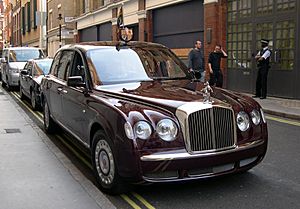
In 1997, Vickers decided to sell Rolls-Royce Motors. BMW AG seemed like the right buyer because they already supplied engines for Bentley and Rolls-Royce cars. BMW offered £340 million, but Volkswagen AG offered more, £430 million. Volkswagen AG bought the car designs, model names, factories, and the famous Spirit of Ecstasy and Rolls-Royce grille trademarks. However, they did not get the rights to the Rolls-Royce name or logo. Those belonged to another company.
BMW paid Rolls-Royce plc £40 million to use the Rolls-Royce name and logo. After talking, BMW and Volkswagen AG agreed. From 1998 to 2002, BMW would keep supplying engines and parts. Volkswagen could also use the Rolls-Royce name and logo temporarily. All BMW engine supplies stopped in 2003.
From January 1, 2003, Volkswagen AG became the only company making cars with the "Bentley" name. BMW started a new company, Rolls-Royce Motor Cars Limited. They built a new factory in England to make Rolls-Royce cars.
Growing Bentley's Business
After buying Bentley, Volkswagen spent about £500 million (around US$845 million) to make the Crewe factory modern. They also wanted to make more cars. By 2010, about 3,500 people worked at Crewe. This was a big increase from 1,500 workers in 1998. Volkswagen invested almost US$2 billion in Bentley to help it grow. Now, the car bodies arrive at the Crewe factory already painted for final assembly. The parts come from Germany.
Bentley cars were so popular that the Crewe factory couldn't make enough. There was a waiting list of over a year for new cars. So, some of the new Flying Spur cars were made in Germany. This stopped in 2006, and all car production went back to Crewe.
Bentley gave Queen Elizabeth II a special State Limousine in 2002. This was to celebrate her 50 years as Queen. Production of the two-door convertible Bentley Azure ended in 2003. It was replaced by a big luxury car called the Bentley Continental GT.
In 2005, Bentley announced a new four-seat convertible, the Azure. It started being made in Crewe in 2006. A convertible version of the Continental GT, called the Continental GTC, was also shown in 2005. Both models were launched in late 2006.
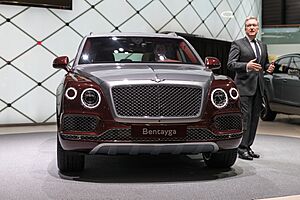
A special version of the GT, called "GTZ," was announced in 2008.
A new version of the Bentley Continental, the Continental Supersports, was shown in 2009. This car was very powerful. It could also use special fuel that was better for the environment.
Bentley sales kept growing. In 2005, they sold 8,627 cars worldwide. In 2007, they sold over 10,000 cars for the first time. They also made a record profit of €155 million. However, in 2009, sales dropped by 50% to 4,616 cars. The company lost €194 million that year. Because of lower sales, production at Crewe stopped for a while in 2009. Sales went up by 11% in 2010, but the company still lost money.
In 2011, sales increased by 37% to 7,003 cars. The new Continental GT was a big reason for this. The company made a profit in 2011 after two years of losses. Today, about 4,000 people work at Bentley.
In March 2020, Bentley stopped production because of the COVID-19 pandemic. In June 2020, Bentley announced they would cut about 1,000 jobs in the UK.
In November 2020, Bentley announced that all new cars they sell will be electric by 2030. This follows a plan in the UK to stop selling non-electric cars by 2030.
Bentley Sales and Staff
| Year | Profit or loss € million |
Staff | Total deliveries |
Americas | China | Europe exc UK |
UK | Middle East |
Asia Pacific |
Japan | Other |
|---|---|---|---|---|---|---|---|---|---|---|---|
| 1998 | 1500 | 414 | |||||||||
| 1999 | 1001 | ||||||||||
| 2000 | 1469 | ||||||||||
| 2001 | 1429 | ||||||||||
| 2002 | 1157 | 36 | |||||||||
| 2003 | 1017 | ||||||||||
| 2004 | 7411 | ||||||||||
| 2005 | 8627 | 3654 | 500 | 4473 | |||||||
| 2006 | +137 | 9387 | 4035 | 175 | 2024 | 3153 | |||||
| 2007 | +155 | 10014 | 4196 | 338 | 2166 | 2079 | 1235 | ||||
| 2008 | +10 | 7605 | |||||||||
| 2009 | −194 | 3500 | 4616 | 1433 | 489 | 897 | 1797 | ||||
| 2010 | −245 | 5117 | 1525 | 910 | 776 | 982 | 924 | ||||
| 2011 | 8 | 4000 | 7003 | 2021 | 1839 | 1187 | 1031 | 566 | 249 | 110 | |
| 2012 | 100 | 8510 | 2457 | 2253 | 1333 | 1104 | 815 | 358 | 190 | ||
| 2013 | 176 | 10120 | 3140 | 2191 | 1480 | 1381 | 1185 | 452 | 291 |
Bentley's global sales went up by 31% in 2021. This happened even with problems from the global pandemic.
Bentley Car Models
| Model Name | Introduced | Discontinued | Class |
|---|---|---|---|
| 3 Litre | 1921 | 1929 | Sports car |
| 3.5 Litre | 1933 | 1939 | Luxury car |
| 4 Litre | 1931 | 1931 | Luxury car |
| 4 1/2 Litre | 1927 | 1931 | Sports car |
| Speed Six | 1926 | 1930 | "Rolling chassis" |
| 8 Litre | 1930 | 1932 | Luxury car |
| Arnage | 1998 | 2009 | Luxury car |
| Azure | 1995 | 2009 | Grand tourer |
| Bentayga | 2015 | Luxury SUV | |
| Brooklands | 1992 | 2011 | Luxury car
Grand tourer |
| Continental | 1952 | ||
| Continental GT | 2003 | Grand tourer | |
| Eight | 1984 | 1992 | Luxury car |
| Flying Spur | 2005 | Luxury car
Ultra-luxury car |
|
| Mark V | 1939 | 1941 | Luxury car |
| Mark VI | 1946 | 1952 | Luxury car |
| Mulsanne | 1980 | 1992 | Luxury car |
| Mulsanne | 2010 | 2020 | Luxury car |
| R Type | 1952 | 1955 | Luxury car |
| S1 | 1955 | 1959 | Luxury car |
| S2 | 1959 | 1962 | |
| S3 | 1962 | 1965 | Luxury car |
| State Limousine | 2002 | 2002 | Luxury car
Limousine Official state car |
| T-Series | 1965 | 1980 | Luxury car |
| Turbo R | 1985 | 1999 |
Current Bentley Models (Volkswagen Era)
- 2016–present: Bentayga
- 2024–present: Continental GT (Gen 4)
- 2019–present: Flying Spur (Gen 3)
Past Bentley Models (Volkswagen Era)
- 1998–2009: Arnage
- 2003–2011: Continental GT
- 2005–2013: Continental Flying Spur (Gen 1)
- 2006–2009: Azure (Gen 2)
- 2008–2011: Bentley Brooklands (Gen 2)
- 2010–2020: Mulsanne
- 2011–2018: Continental GT (Gen 2)
- 2013–2019: Flying Spur (Gen 2)
- 2018–2024: Continental GT (Gen 3)
Special Edition Bentley Cars
- 1999: Hunaudières Concept
- 2002: State Limousine
Bentley in Racing
A Bentley Continental GT3 racing car won a race in 2014. This was Bentley's first official race in Britain since 1930.
See also
 In Spanish: Bentley Motors Limited para niños
In Spanish: Bentley Motors Limited para niños
- List of car manufacturers of the United Kingdom


